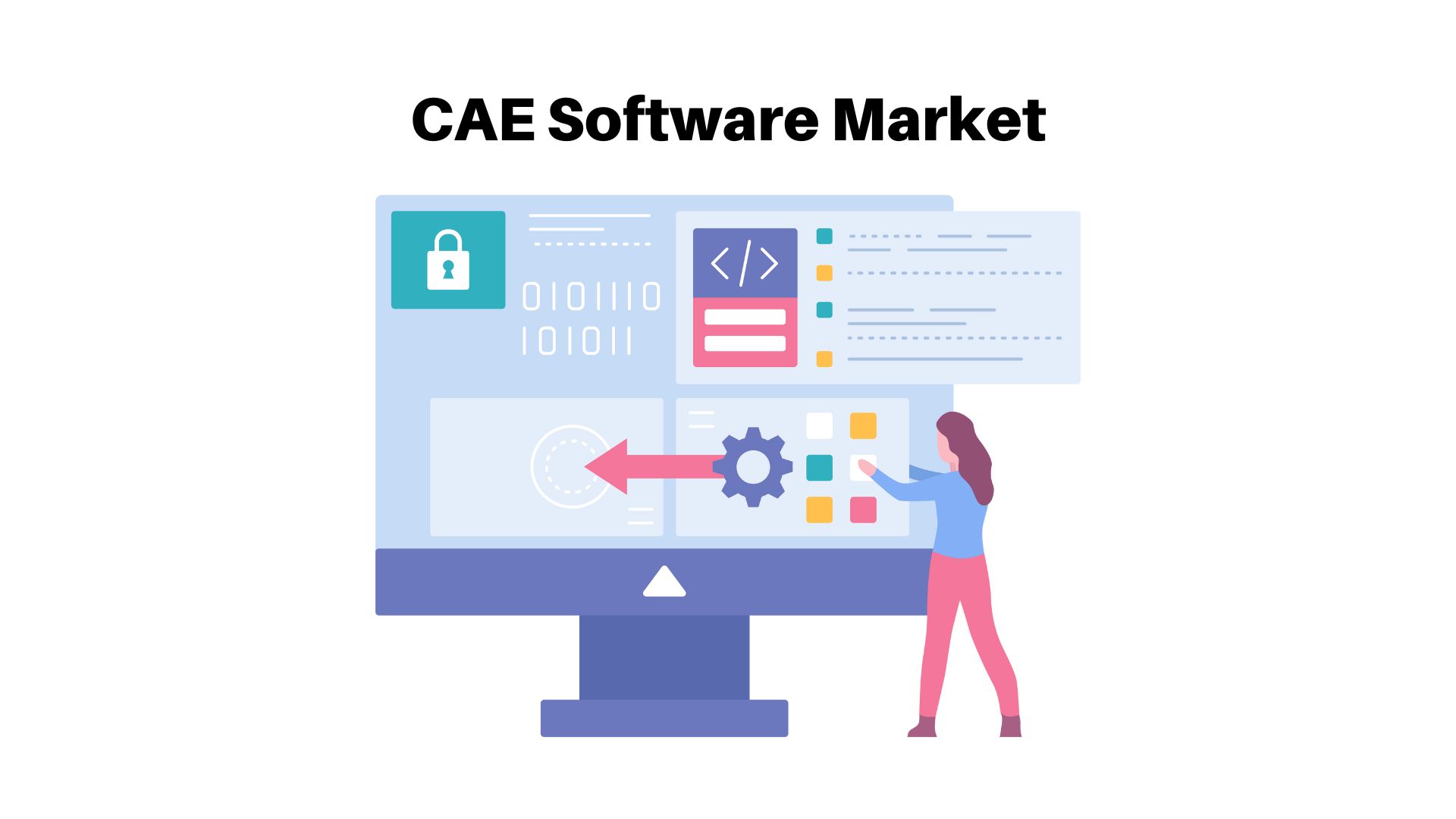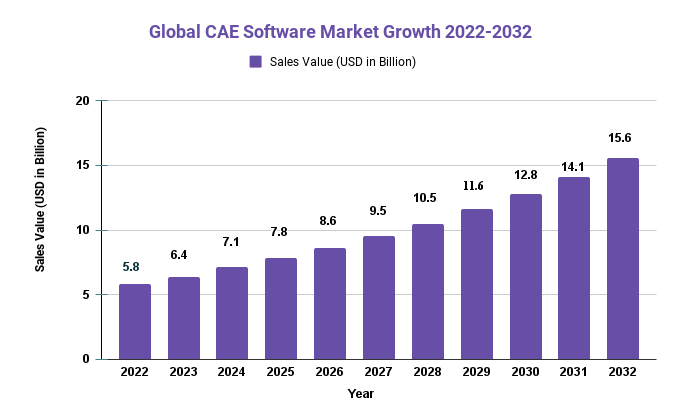CAE Software Market is Estimated to Showcase Significant Growth of USD 15.6 Bn in 2032 With a CAGR 10.4%

Page Contents
Market Overview
Global CAE Software Market size is forecast to reach USD 15 Bn by 2032 from USD 5.8 Bn in 2022, growing at a compound annual growth rate (CAGR) of 10.4% between 2023 and 2032.
CAE software is used to simulate and analyze product designs before they are manufactured, thus saving development time and costs. It has applications across industries such as aerospace, automotive, defense, electronics, and healthcare.
The aerospace industry is the primary user of CAE software, followed by the automotive, defense, and electronics industries. North America leads the global CAE software market followed by Europe and Asia Pacific. Major players in this space include ANSYS, Siemens PLM Software, Dassault Systemes, Altair Engineering, and MSC Software.
The drivers for the CAE software market include a need to reduce product development time and costs, rising demand for advanced simulation software in aerospace, automotive, and defense industries, rising adoption of cloud-based CAE solutions, advances in virtual testing and simulation techniques, as well as rising interest in medical devices and equipment.
Drivers, trends, and challenges have an impact on market dynamics, which can impact businesses. Request for PDF sample report

Key Takeaways
- The CAE Software Market size is projected to reach USD 15 billion by 2032 from an initial value of 5.8 Bn in 2022, growing at an annual compound growth rate (CAGR) of 10.4% between 2023 and 2032.
- The aerospace industry is the top user of CAE software, followed by the automotive, defense, and electronics sectors.
- North America accounts for the majority of CAE software sales globally, followed by Europe and Asia Pacific.
- The leading players in the CAE software market include ANSYS, Siemens PLM Software, Dassault Systemes, Altair Engineering, and MSC Software.
Regional Snapshot
North America is the leading market for CAE software, due to the presence of major players and the adoption of advanced technologies in the aerospace and defense industries. Europe's CAE software market is also growing rapidly due to increasing demand for advanced simulation software in the automotive and aerospace sectors. The Asia Pacific region is forecasted to experience the highest growth rate during this forecast period due to the increased adoption of CAE software across manufacturing and healthcare sectors.
Drivers
Reduce product development time and costs through CAE software: Companies can test product designs virtually, eliminating the need for physical prototypes, thus saving both time and money during the product development process.
In the aerospace, automotive, and defense industries, there is an ever-increasing need for advanced simulation software. CAE software is widely used to model and analyze complex product designs to guarantee safety and dependability.
Cloud-based CAE software's Growing Adoption: Cloud-based CAE software offers the convenience of accessing it remotely, without needing costly hardware and software installations, which has led to its growing adoption.
Advancements in virtual testing and simulation: Recent advancements in this field of virtual testing and simulation have enabled more accurate, realistic simulations, thus increasing demand for CAE software.
Rising demand for medical devices and equipment: CAE software is increasingly being utilized in the healthcare industry to simulate and test medical devices and equipment, further fueling its demand in this sector.
Restraints
Expensive CAE software: CAE software can be costly, which may prevent its widespread adoption by small and medium-sized enterprises.
Lack of Skilled Professionals in the Field: Due to a shortage of experienced personnel who can efficiently use and implement CAE software, adoption may be limited.
Data Privacy and Security Issues: Utilizing CAE software exposes sensitive data and intellectual property that could be vulnerable to cyber attacks or data breaches
Lack of awareness regarding the advantages of CAE software: Many businesses may not be aware of its advantages, which could limit its adoption.
Integration Issues with Existing Software and Systems: Integrating CAE software with existing software and systems may prove a complex endeavor, potentially restricting its adoption.
Technical Challenges and Compatibility Issues: Utilizing CAE software may necessitate technical proficiency, while compatibility issues between different hardware and software systems could prevent its widespread adoption.
Opportunities
- Rising demand for electric and autonomous vehicles.
- Increased use of CAE software in the healthcare industry.
- Expansion of aerospace industry in emerging economies.
Challenges
- Lack of awareness regarding the advantages of CAE software.
- Integration problems with existing programs and systems.
- Technical complexity and incompatibility problems.
Grow your profit margin with Market.us – Acquire this Report
Recent Developments
- In February 2021, Altair Engineering acquired Ellexus, a provider of I/O profiling and analysis tools for HPC (high-performance computing) and cloud environments.
- In November 2020, Siemens PLM Software unveiled its upgraded Simcenter 3D software which now includes simulation capabilities for electromagnetics, fluid dynamics, and structural analysis.
- In October 2020 ANSYS acquired Lumerical, a provider of photonic simulation software.
Key Market Segments
Type
- Mono Functional
- Multi-Functional
Application
- Machine Tool Industry
- Automobile & Train Industry
- Shipbuilding Industry
- Aerospace & Defense Industry Applications
Key Market Players
- Siemens PLM Software
- ANSYS
- Dassault Systemes
- Hexagon AB
- MSC Software
- Alatir
- ESI
- PTC
- Autodesk
- COMSOL Multiphysics
- BETA CAE Systems
- Magma
- CoreTech System
- Toray Engineering
- Yuanjisuan
- Supcompute
Interested to Procure the Data? Inquire here at https://market.us/report/cae-software-market/#inquiry
Report Scope
| Report Attribute | Details |
| The market size value in 2022 | USD 5.8 Bn |
| Revenue forecast by 2032 | USD 15 Bn |
| Growth Rate | CAGR Of 10.4% |
| Regions Covered | North America, Europe, Asia Pacific, Latin America, and Middle East & Africa, and the Rest of the World |
| Historical Years | 2017-2022 |
| Base Year | 2022 |
| Estimated Year | 2023 |
| Short-Term Projection Year | 2028 |
| Long-Term Projected Year | 2032 |
Frequently Asked Questions
Q: What is CAE software?
A: CAE (Computer-Aided Engineering) software is a type of program used by engineers to simulate and analyze product and system performance in a virtual setting. This enables engineers to design, test, and optimize products before they're actually built – saving both time and money during the product development process.
Q: Which industries utilize CAE software?
A: CAE is used across many industries, such as automotive, aerospace, defense, electronics, energy and medical devices. Any business that designs and manufactures complex products can benefit from using this cutting-edge software
Q: What are some advantages of CAE software?
A: Some advantages include faster time-to-market for products, reduced development costs, improved product quality, and innovation, as well as the capability to analyze complex product designs that would be difficult or impossible to test in real life.
Q: How is the CAE software market expected to develop over the coming years?
A: The CAE software market is projected to experience steady growth through 2025 due to increasing demand for simulation and analysis software in industries such as automotive, aerospace, and defense.
The team behind market.us, marketresearch.biz, market.biz and more. Our purpose is to keep our customers ahead of the game with regard to the markets. They may fluctuate up or down, but we will help you to stay ahead of the curve in these market fluctuations. Our consistent growth and ability to deliver in-depth analyses and market insight has engaged genuine market players. They have faith in us to offer the data and information they require to make balanced and decisive marketing decisions.



